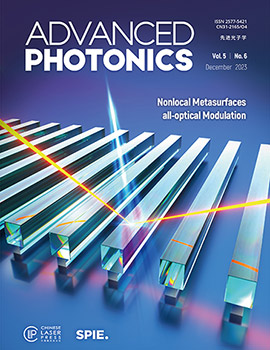300公里光纤中独立单光子源的量子干涉
IF 18.8
1区 物理与天体物理
Q1 OPTICS
引用次数: 5
摘要
摘要在寻求实现可扩展量子网络的过程中,半导体量子点(QDs)提供了独特的优势,包括高单光子效率和不可区分性、高重复率(Purcell增强后为数十吉赫兹)、与自旋量子位的互连性以及可扩展的片上平台。然而,在过去的二十年里,独立量子点之间量子干涉的可见性很少超过50%的经典极限,距离也被限制在几米到几公里之间。在这里,我们报道了由302公里光纤分离的独立量子点的两个单光子之间的量子干涉。单光子是由确定耦合到微腔的共振驱动的单量子点产生的。量子频率转换用于消除QD不均匀性并将发射波长转移到电信频带。观测到的干扰能见度为0.67 ± 0.02(0.93 ± 0.04),而没有(具有)时间滤波。可行的改进可以将距离进一步延长至~600 我们的工作代表着向长距离固态量子网络迈出了关键一步。本文章由计算机程序翻译,如有差异,请以英文原文为准。
Quantum interference with independent single-photon sources over 300 km fiber
Abstract. In the quest to realize a scalable quantum network, semiconductor quantum dots (QDs) offer distinct advantages, including high single-photon efficiency and indistinguishability, high repetition rate (tens of gigahertz with Purcell enhancement), interconnectivity with spin qubits, and a scalable on-chip platform. However, in the past two decades, the visibility of quantum interference between independent QDs rarely went beyond the classical limit of 50%, and the distances were limited from a few meters to kilometers. Here, we report quantum interference between two single photons from independent QDs separated by a 302 km optical fiber. The single photons are generated from resonantly driven single QDs deterministically coupled to microcavities. Quantum frequency conversions are used to eliminate the QD inhomogeneity and shift the emission wavelength to the telecommunication band. The observed interference visibility is 0.67 ± 0.02 (0.93 ± 0.04) without (with) temporal filtering. Feasible improvements can further extend the distance to ∼600 km. Our work represents a key step to long-distance solid-state quantum networks.
求助全文
通过发布文献求助,成功后即可免费获取论文全文。
去求助
来源期刊

Advanced Photonics
OPTICS-
CiteScore
22.70
自引率
1.20%
发文量
49
审稿时长
18 weeks
期刊介绍:
Advanced Photonics is a highly selective, open-access, international journal that publishes innovative research in all areas of optics and photonics, including fundamental and applied research. The journal publishes top-quality original papers, letters, and review articles, reflecting significant advances and breakthroughs in theoretical and experimental research and novel applications with considerable potential.
The journal seeks high-quality, high-impact articles across the entire spectrum of optics, photonics, and related fields with specific emphasis on the following acceptance criteria:
-New concepts in terms of fundamental research with great impact and significance
-State-of-the-art technologies in terms of novel methods for important applications
-Reviews of recent major advances and discoveries and state-of-the-art benchmarking.
The journal also publishes news and commentaries highlighting scientific and technological discoveries, breakthroughs, and achievements in optics, photonics, and related fields.
 求助内容:
求助内容: 应助结果提醒方式:
应助结果提醒方式:


